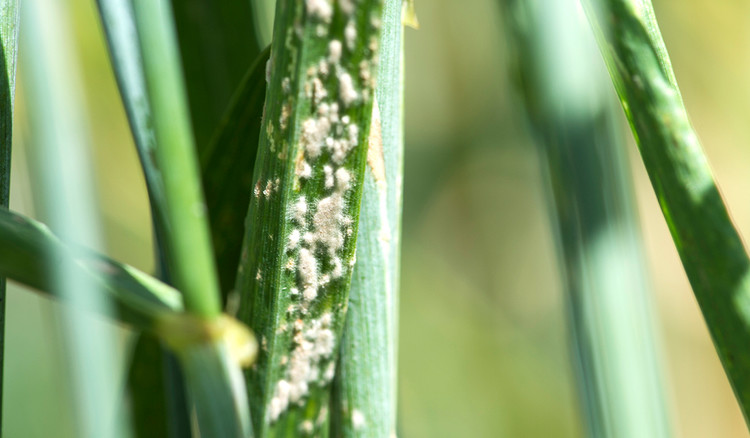
How to manage powdery mildew (Erysiphe graminis) in barley

Photo credit: Thomas Lumpkin/CIMMYT.
Powdery mildew is a fungal disease that thrives under dry conditions with high relative humidity. These conditions typically occur in spring when the plants have covered up most of the soil surface area. The dense barley population reduces air circulation which leaves the immediate air surrounding the plant humid. Large day and night temperature differentials also come into play at this time of the year, which contributes to favourable powdery mildew conditions.
The disease cycle and what to look for?
The first sign of powdery mildew on barley is usually small yellow spots on the leaves. More easily noticed are the next phase when, several days later, a fluffy grey-white fungus appears. This spreads forming a powdery coating. The disease spreads quickly and can heavily infect the crop within four weeks.
The fruiting bodies of hordei can be detected later as black dots in the fungus, usually near the stem of the plant. These produce spores, which are dispersed by wind and insects. In fallow periods, the fungus can lie dormant in crop debris and on volunteer hosts.
What are the effects of powdery mildew on barley?
The fungus draws on the plant’s food store by entering the cells usually on the leaf surface. Photosynthesis is inhibited as the surface of the leaf is covered, weakening the plant and impacting growth. All the parts of the plant above the ground can be infected; leaves will yellow and drop off.
A plant with powdery mildew on it will focus its energy and resources on fighting the disease, which means less energy and resources allocated to vegetative and reproductive growth. The result is reduced yields and potentially an unmarketable crop due to inferior quality grains.
According to South Africa’s Agricultural Research Council and Western Australia’s Department of Primary Industries and Regional Development: Agriculture and Food division, yield loss in early plantings of susceptible barley varieties can be as high as 25 per cent - late infection can cost up to 10 per cent.
It is therefore important to implement a disease control strategy as a preventative measure to control powdery mildew, rather than a reactive control method.

Photo credit: afren.com.au
Preventive measures
The starting point for powdery mildew treatment is actually a preventative strategy. First, select a variety that is less prone to powdery mildew. Also consider the microclimate in the desired planting area and whether or not it will have higher or lower relative humidity. Use a thorough integrated pest management program to reduce the probability of powdery mildew occurring. Be proactive in your integrated pest management strategy – do not wait until the disease is present before taking action.
Agrochemicals form an essential part of the integrated pest management strategy for controlling diseases. The first fungicide application usually occurs around the time that the second node of the plant is visible. This fungicide is usually a systemic product that will provide protection for a longer period of time – therefore it will typically have a longer pre harvest interval.
The second application is usually around the time when the ligule of the last leaf is just visible. In this application timing farmers can consider a product like Orius 250 EW – also a systemic fungicide to ensure the plant is protected through peak powdery mildew conditions.
The final application will occur when the barley head is visible. Here farmers can consider Bumper® 250 EC. Bumper® 250 EC also moves systemically but is broken down quicker by the plant than most other registered systemic products and as such it has a shorter pre harvest interval. Using this product last (according to the pre harvest interval on the label) ensures that the farmer has late-season protection against powdery mildew whilst adhering to the legal maximum residue limit.
The most important aspect to remember when planning a spray program for barley is that the entire plant (individual leaves, stem and ear) contributes energy equally to obtain the final yield. Therefore, it is important to protect the entire plant against yield-reducing diseases such as powdery mildew. In some cases it might even warrant additional fungicide applications than the typical ones described above if the growing season is extended or severe disease pressure occurs.
In summary, the best fungicide control to prevent powdery mildew will be achieved when the correct variety is planted in the correct area in combination with an integrated pest management strategy that is proactively managed.
For more advice on managing crop diseases, visit our Crop Protection page.
Sources: